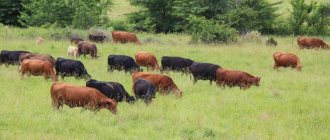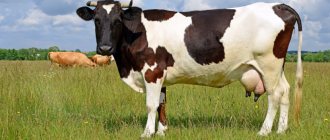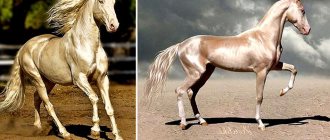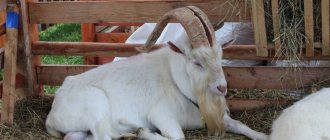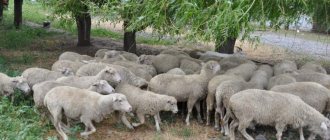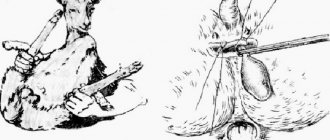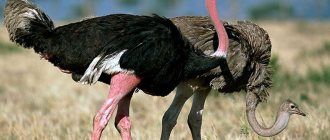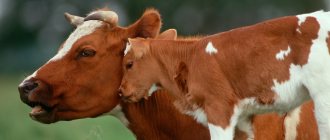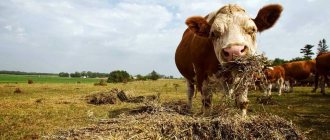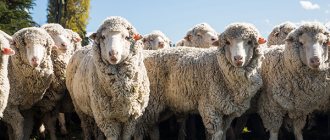Timing and organization of pasture use
How to use pasture rationally:
- analyze grass yields;
- calculate the timing of plants being eaten by animals;
- determine the permissible number of individuals per hectare of area.
The time of pasture use is limited by the maturation and restoration of grass cover. To prevent animals from trampling down the grass too quickly, the area is divided into squares and portable fences are installed. When the sheep eat the grass in one area, the partitions are moved to the next square and the animals are transferred there. The grass cover is restored within a month. Therefore, the flock is allowed into the first area no earlier than this time. The area of the plots is calculated so that the herd has enough food for a week.
Keeping young animals
When lambs are born in winter, fattening will occur just at the end of the winter period, so you need to think in advance about feeding young offspring and prepare separately balanced feed for them.
It is customary to make special feeding troughs for lambs. The ewe feeds the lambs with milk for about 2 months. In the first month, in parallel with mother's milk, they begin to give dry concentrates little by little, gradually increasing their quantity. When switching lambs to adult feed in winter, problems with the routine may arise, so it is best to initially accustom the animals to feeding by the hour. At first, the feeding frequency is 5 times a day; from 2 months of age, lambs are transferred to 2 meals a day. After mixed feed, legumes and cereal-legume dried herbs are gradually introduced into the diet of babies.
In winter, when the weather is good, you need to let your kids go outside. An important point is vaccination of young animals. Before it, preventive deworming is carried out.
Grazing rules
Animals are gradually transferred from confinement to grazing on pasture.
Preparation
A sharp transition from winter keeping in a barn to grazing causes digestive upset in sheep. Therefore, the flock is prepared according to the following rules:
- released to graze for an hour in the afternoon;
- before grazing they are fed with hay;
- upon returning to the barn, they give plenty of water.
General preparation rules:
- conduct a veterinary examination of animals, vaccination against ticks, parasites and infections;
- trim the hair on the hooves and around the eyes;
- divide the herd into flocks based on age and wool quality.
The pasture is preliminarily inspected, places for rest and grazing are designated, and a movement schedule is drawn up.
Schedule
Sheep are released to pasture in late spring - in the middle or end of May, depending on the climate. At the beginning of the month, the grass is not yet tall enough and nutritious.
Grazing begins at dawn. Approximate schedule:
| Time | Action | Description |
| 05:00 | The flock is driven out to pasture | Early in the morning it is not hot and there are no blood-sucking insects. |
| 11:00-12:00 | Sheep are driven into the shade, to the river for an afternoon rest | The daytime crossing begins earlier on particularly hot days. If the weather is cool and cloudy, the herd is not moved or grazed until noon |
| 15:00 | The herd is taken out to pasture | The heat is subsiding |
| 20:00-21:00 | Otaru is taken home | In summer, the herd can stay in the meadow longer |
During spring grazing, sheep are turned out to the legume area after the morning dew has subsided and before the evening dew falls. Young moist stems ferment in the stomachs of animals, and as a result, the disease tympania develops.
Features of summer grazing:
- early arrival due to dew;
- moving to the shade to chew grass;
- night grazing.
Animals are brought to the field at 18:00. They feed until one in the morning, rest for two hours and feed again until ten or eleven in the morning. During the day, the herd rests in the sheepfold. In summer, dew softens grains and helps them digest better. But you should not graze your flock on wet alfalfa.
During winter grazing, the herd is released to pasture at 11 am. Covered parking lots with a supply of hay and water are equipped on the territory. In case of bad weather, animals are driven under shelters. Sheep farming uses grazing methods without a shepherd. Animals are kept in open pens with electric current running through the fences. Low voltage is safe for the ram, ewe and lamb, but will prevent the herd from scattering around the area.
See also
Description and characteristics of sheep of the Tashlin breed, maintenance rulesRead
Organization of a watering place
In summer, sheep find it more difficult to tolerate thirst than hunger. On hot days, animals are given water three times a day. In autumn, the number of trips to watering places is reduced to two times. On particularly cool days, sheep are given water once a day.
The maximum distance a herd can travel is 3 kilometers. If the reservoir is located further away, water is transported to the pasture. Sheep that travel long distances every day gain weight worse.
Sheep Resources
Before getting involved in the development of sheep farming, it is necessary to assess your own resources for this type of activity.
- Sheep farming is a business, so before you start it, you need to study the business from different aspects.
- Sheep will require care, so it is important to have the time and physical strength to do the work.
- An important resource is the nutrition of sheep; it is important to decide what the sheep will eat - natural or purchased food.
- It is necessary to prepare good pens and fences for sheep, the height of which should be appropriate, since sheep can jump high.
- It is necessary to prepare a water supply, water tanks, hay containers and shields of different sizes.
- Each sheep needs to be allocated 15 to 25 square meters of space in the pen.
Tips and tricks
How to start herding sheep:
- during the first grazing, do not move frequently from one place to another, so as not to disturb;
- young animals and breeding stock are brought to the best lands;
- graze in a deployed formation so as not to trample the area;
- When choosing terrain, give preference to areas with a high content of white clover and timothy.
In summer, sites should be changed every 12 days to reduce the likelihood of infection with worms and parasitic blow flies;
Sales market
Recently, the demand for sheep skins and wool has dropped significantly, but there is always a way out for resourceful entrepreneurs. You can try to organize the production of sheep wool products. With the right advertising campaign, reminding citizens of the environmental friendliness of these items and their high warming properties, you can establish a profitable business in the sale of products made from sheep skin and wool. One video clip on the Internet can provide a farm with orders for several years in advance.
Sheep milk and cheese are difficult to sell, despite their impressive beneficial properties for the human body. Buyers are put off by the unusual taste and smell. Most likely, there will be a need to enter into an agreement with a local dairy plant. Over time, you can organize your own production. If there are good technologies and interesting recipes for making different types of cheese, success is absolutely possible. But don’t forget about advertising; a video released on the Internet telling about the beneficial properties of sheep’s cheese can become a very effective PR move.
Meat is by far the easiest to sell. If the emphasis is placed on it, then it is better to breed meat breeds on the farm, for example, Edilbaev sheep, Texel or Gissar breeds. Meat can be delivered to meat processing plants, stores, or sold on the market yourself.
Share
What difficulties may arise
Before you start grazing you need to know that:
- spring grass contains a lot of potassium. Sheep suffer from convulsions from excess of the substance. Excess potassium is balanced with sodium, which is contained in salt. The daily norm for an adult animal in the spring is 10 grams;
- hatching on alfalfa is alternated with feeding on natural pasture. The stems of the plant are covered in the stomach with ordinary herbs and are better absorbed;
- Not all clover is good for sheep. A plant with red flowers in the first year of growth contains a nerve poison. Sheep are allowed into the red clover field after harvesting in the second year;
- The sheep huddle tightly together and keep each other warm. The herd instinct is useful in winter, but dangerous in summer. Animals must be separated to prevent heatstroke.
The health and fatness of the sheep depend on the skill of the shepherd. An experienced shepherd understands useful and harmful herbs and determines the duration of grazing based on the weather.
User manual
Electric shepherds have a simple design. When operating, follow simple safety rules:
- Install a reliable grounding system.
- Equipment adjustment is prohibited under voltage.
- The power goes out during a thunderstorm.
- During periods of precipitation, avoid contact with fence elements.
- When installing, follow the layout of the support pillars.
- Avoid the presence of small children in areas where installation work is carried out.
To prevent the sheep from getting hurt, they must have a clear view of the fence. Visual contact helps you quickly remember a dangerous place.
The electronic control system has good development prospects. Electronic shepherds are already being actively used on farms. The device helps keep livestock on pasture and preserves crops outside the fence.
Sheep grazing rate per 1 ha
The rate of grass consumption depends on the type of pasture and the number of sheep.
To calculate how many animals should graze on one hectare of field, use the following formula:
G = U / N x P
Formula variables mean:
- G - number of sheep;
- Y is the yield per hectare multiplied by the percentage of pasture use;
- N is the amount of green mass that sheep eat during grazing;
- P is the period of use of pasture.
Natural lands are used by 60 percent, and artificial ones by 90. Grazing lasts 6 hours without taking into account the midday rest. One sheep eats 2 kilograms of greens per hour or 12 kilograms per day on grazing.
Self-construction of a sheepfold
Materials for construction can be completely different. It all depends on what building material is the cheapest and most accessible in a particular area. A sheepfold can be built from stone, wood, adobe, cinder concrete, etc.
Let's consider the project of a sheepfold for 100 heads. This is the optimal number of sheep to keep. Keeping them in small groups of 5-10 animals is unprofitable from all points of view. Firstly, it is unprofitable in terms of doing business. Secondly, due to the psychological characteristics of sheep, they feel much better when they are in a fairly large group of their own kind.
Due to the fact that one sheep must have at least 1.5 square meters. m of living space, and if it is a queen with offspring, then the area doubles, respectively, the area of a sheepfold for 100 heads is at least 300 sq. m. m. A little more is better. Based on this area of the future building, it is necessary to plan the volume of purchases of appropriate building materials.
Construction of the foundation
Capital construction always begins with the construction of a foundation. It is the foundation of any structure. In this sense, the sheepfold is no exception. And the construction of the foundation must be taken very seriously. Otherwise, we risk the destruction of the walls and the entire building as a whole after the first winter.
Of all the types of foundations for building a sheepfold, columnar foundations are best suited. This type is justified both from an economic point of view (it is cheaper) and from a practical point of view (less labor-intensive in terms of construction). To build a columnar foundation, you need to purchase a special tool - a hand drill. With its help, holes of appropriate depth are drilled in the soil.
Diet
The menu for ram meat breeds consists of three components:
- green food - fresh grass for pasture, silage in winter;
- roughage - straw from green legumes, barley, oats, alfalfa hay, clover, canned haylage;
- vegetables - fodder beets, carrots, pumpkin, zucchini;
- concentrates - grains of wheat, oats, corn, bran, sunflower cake.
Daily ration of adult sheep for fattening:
| Product | Norm in kilograms | |
| For adult animals | For lambs up to 6 months | |
| Clover or alfalfa hay | 1,5-2 | 1,5 |
| Silage, fresh grass | 2-5 | 1,5 |
| Concentrate | 0,5 | 0,3 |
To quickly gain weight, animals require proteins. Their highest content is in concentrates from peas, barley and corn. They also give mineral supplements - chalk is mixed into the crushed grain. Feeders for fattened animals are constantly filled. Concentrates are given after the sheep have drunk, and green and roughage - before the water is supplied.
Business plan for sheep breeding
You should start by drawing up a business plan - it must be clearly drawn up and analyzed. You can contact special organizations to draw up a business plan, or you can find a ready-made business plan on the Internet and adapt it to your requirements and conditions. It makes sense to consult with experienced herders on how to raise sheep.
First of all, you will need to purchase or rent a pasture; its area directly depends on the number of sheep in the flock: one hectare of pasture is the norm to feed one sheep family.
Forages with optimal composition grow on the soils of the Stavrapol region, the North Caucasus and Astrakhan; plots here are quite expensive. Slightly worse is the food that grows in the Chernozem and Central regions. It is necessary to compensate for the lack of nutrients in these feeds by feeding the sheep with grain, otherwise they will not reach the desired weight. You will have to spend money on grain, so sheep farming costs will be higher in these areas.
The sheep are frost-resistant and live in wooden pens that do not require heating. It is enough to install a small heater in very cold times. You will need housing for a shepherd.
You should purchase sheep only from certified farms; it is better to buy livestock from several different farms at once.
Do-it-yourself sheepfold
After drawing up the project, you need to write a list of the necessary materials. This is the most expensive expense item when creating a sheepfold. In order for DIY construction to be budget-friendly, you need to think through everything in advance and not spend on excess.
Required materials and tools
Most often, brick or wood is used to build such a shed. Depending on the area of residence, you can build from clay with straw or sandwich panels.
Did you know? In ancient times, pens were made of stone. Sheep are distinguished by their remarkable strength, especially males, and they can easily demolish more fragile structures.
Let's consider the necessary material for the most common types of construction, namely a wooden or brick version. In the first case, you will need woodworking equipment:
- plane and jigsaw,
- a circular saw,
- screwdriver and screws,
- hammer, nails, tape measure,
- tree.
To implement the second option you will need:
- cement, sand,
- putty knife,
- trough for preparing the solution,
- brick.
- heating system,
- ventilation,
- wiring,
- water pipes,
- doors,
- window openings,
- roof.
Step-by-step production
The construction of the pen takes place in several simple stages, each of which has its own nuances.
Foundation For the strength and durability of the structure, we begin the process by creating a foundation in the form of concrete columns. We pour the concrete solution around the wooden formwork, previously driven into a shallow hole. At the same time, we insert a metal pin into each post, which will hold the floor in the future. It will be interesting to learn how to raise orphan lambs.
Frame We lay a layer of waterproofing on the foundation, and then make a frame from vertically installed boards.
Walls, windows and doors The next step is to build the walls - laying bricks or nailing wooden sheathing onto support beams (in the case of wooden walls), which is covered with boards on the outside.
Important! When implementing a wooden floor, it is made higher by a few centimeters and at a slight angle. This promotes faster sewage drainage and drainage
Roof The walls are covered with transverse beams on top, on which the roofing material is laid. It is advisable to insulate the roof (hay would be ideal) to reduce heat loss.
